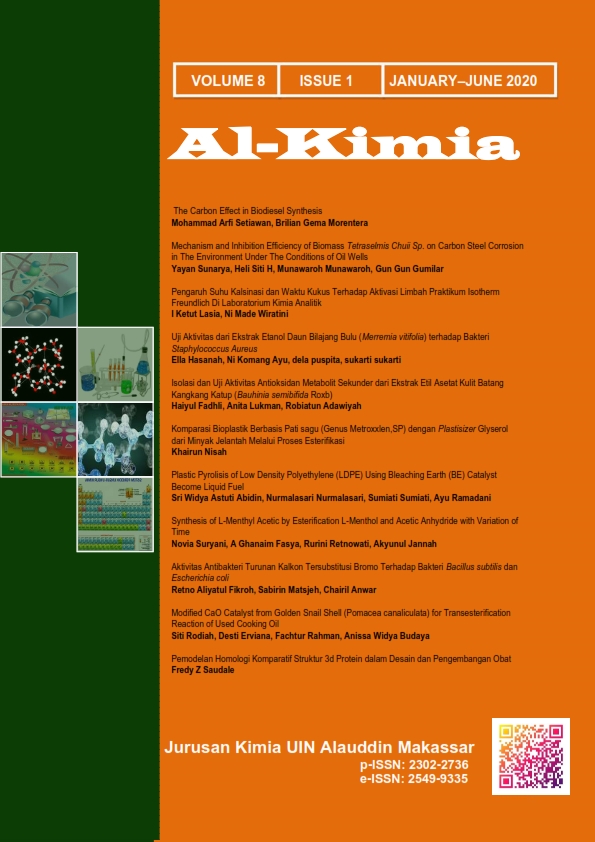Plastic Pyrolisis of Low Density Polyethylene (LDPE) Using Bleaching Earth (BE) Catalyst Become Liquid Fuel
Abstract
This study aims to determine the effect of adding Bleaching Earth (BE) catalyst to the amount of liquid fraction by pyrolysis of Low Density Polyethylene (LDPE) and find out the concentration of gasoline and diesel fractions from plastic pyrolysis Low density polyethylene (LDPE). The method in this study is the pyrolysis method (heating without oxygen) and analysis of the liquid fraction resulting from pyrolysis using GCMS (Gas Chromatrographic Mass Spectrometry). In this study, the effect of adding Bleaching Earth (BE) catalyst on Low Densiry Polyethylene plastic pyrolysis is the more catalyst used, the lower the quantity of liquid fraction. Based on GCMS analysis on plastic pyrolysis of Low Density Polyethylene (LDPE) from various variations of Bleaching Earth (BE) catalysts used the optimum concentration was obtained by adding 2.5 g, 5 g, and 7.5 g Bleaching Earth (BE) catalysts to produce fractions higher diesel (C13-C20), 37.04%, 31.04% and 35.59% respectively
Downloads
References
Ćwik, Agnieszka. 2014. “Fuel from Waste - Catalytic Degradation of Plastic Waste to Liquid Fuels,” 10.
Kyaw, Khaing Thandar, and Chaw Su Su Hmwe. 2015. “EFFECT OF VARIOUS CATALYSTS ON FUEL OIL PYROLYSIS PROCESS OF MIXED PLASTIC WASTES” 8 (5): 794–802.
https://doi.org/10.1016/j.rser.2015.10.015.
Miskolczi, N., A. Angyal, L. Bartha, and I. Valkai. 2009. “Fuels by Pyrolysis of Waste Plastics from Agricultural and Packaging Sectors in a Pilot Scale Reactor.” Fuel Processing Technology 90 (7–8): 1032–40. https://doi.org/10.1016/j.fuproc.2009.04.019.
Nurmalasari, Wega Trisunaryanti, Iip Izul Falah, and Sutarno. 2016. “Mesoporous Silica Impregnated by Ni and NiMo as Catalysts for Hydrocracking of Waste Lubricant” 9 (9).
Patni, Neha, Pallav Shah, Shruti Agarwal, and Piyush Singhal. 2013. “Alternate Strategies for Conversion of Waste Plastic to Fuels.” ISRN Renewable Energy 2013: 1–7. https://doi.org/10.1155/2013/902053.
Sarker, M. 2012. “Fractional Distillation Process Utilized to Produce Light Fractional Fuel from Low Density Polyethylene (LDPE) Waste Plastic.” The Open Fuels & Energy Science Journal 5 (1): 39–46. https://doi.org/10.2174/1876973X01205010039.
Sharuddin, S. D. A., F. Abnisa, W. M. A. W. Daud, and M. K. Aroua. 2018. “Pyrolysis of Plastic Waste for Liquid Fuel Production as Prospective Energy Resource.” IOP Conference Series: Materials Science and Engineering 334 (March): 012001. https://doi.org/10.1088/1757-899X/334/1/012001.
Syamsiro, Mochamad, Shuo Cheng, Wu Hu, Harwin Saptoadi, Nosal Nugroho Pratama, and Kunio Yoshikawa. 2014. “Liquid and Gaseous Fuels from Waste Plastics by Sequential Pyrolysis and Catalytic Reforming Processes over Indonesian Natural Zeolite Catalysts.” Waste Technology 2: 8.
Syamsiro, Mochamad, Harwin Saptoadi, Tinton Norsujianto, Putri Noviasri, Shuo Cheng, Zainal Alimuddin, and Kunio Yoshikawa. 2014. “Fuel Oil Production from Municipal Plastic Wastes in Sequential Pyrolysis and Catalytic Reforming Reactors.” Energy Procedia 47: 180–88. https://doi.org/10.1016/j.egypro.2014.01.212.
Copyright (c) 2020 Sri Abidin

This work is licensed under a Creative Commons Attribution-NonCommercial-ShareAlike 4.0 International License.
Authors who publish with this journal agree to the following terms:
1) Authors retain copyright and grant the journal right of first publication with the work simultaneously licensed under a Creative Commons Attribution License that allows others to share the work with an acknowledgement of the work's authorship and initial publication in this journal.
2) Authors are able to enter into separate, additional contractual arrangements for the non-exclusive distribution of the journal's published version of the work (e.g., post it to an institutional repository or publish it in a book), with an acknowledgement of its initial publication in this journal.
3)Authors are permitted and encouraged to post their work online (e.g., in institutional repositories or on their website) prior to and during the submission process, as it can lead to productive exchanges, as well as earlier and greater citation of published work (See The Effect of Open Access).


